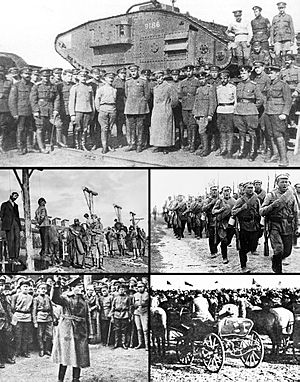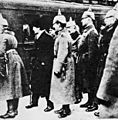Russian Civil War facts for kids
Quick facts for kids Russian Civil War |
|||||||||
|---|---|---|---|---|---|---|---|---|---|
| Part of the aftermath of World War I and the Russian Revolution | |||||||||
 Clockwise from top: Soldiers of the Don Army in 1919; a White infantry division in March 1920; soldiers of the 1st Cavalry Army; Leon Trotsky in 1918; hanging of workers in Yekaterinoslav (Dnipro) by the Austro-Hungarian Army, April 1918. |
|||||||||
|
|||||||||
| Belligerents | |||||||||
|
French volunteers (From 1921) (1919–20) |
Including
Other new republics Including
Allied intervention Including
German-led intervention Including
Other factions
(From March 1918) (From 1919) (1920–21) (1921) Various anti-Soviet factions also fought against each other. |
||||||||
| Commanders and leaders | |||||||||
| Strength | |||||||||
|
Red Army: 5,427,273 (peak) Black Army: 103,000 (peak) |
White Army: 2,400,000 | ||||||||
| Casualties and losses | |||||||||
| ~1,500,000 259,213 killed 60,059 missing 616,605 died of disease/wounds 3,878 died in accidents/self-inflicted deaths 548,857 wounded/frostbitten |
650,000 total casualties | ||||||||
| 7,000,000–12,000,000 combined total casualties, including hundreds of thousands from the White and Red Terrors | |||||||||
The Russian Civil War was a civil war fought from November 1917 until October 1922 between several groups in Russia. The main fighting was between the Red Army and the White Army. The Red Army was an army of communists. The White Army opposed the communists. Other forces fought against both these groups or sometimes helped one against the other. The Red Army won this war because their army was better-organised and they held the best territory. After this war, the communists established the Soviet Union in 1922.
Czar Nicholas II, the traditional ruler of the Russian Empire, had just lost his throne. The Russian Revolution of 1917 had just ended. Many regions forming part of the Russian Empire were not stable. Many groups had organized themselves. The workers and farmers supporting the communists organized themselves into the Red Army. People opposing them organized themselves into the White Army.
In Ukraine, some groups fighting for a free Ukraine organized themselves as the Green Army. There were several other groups. The Green Army and the smaller groups fought each other, and sometimes they fought the Red Army and the White Army. Other nationalist armies fought for independence from any kind of Russian control. Finland, Poland, Lithuania, Latvia and Estonia succeeded.
At the same time, some foreign countries were worried about the communists ruling the Soviet Union. They feared that communism would come to their countries also if the communists were successful so they helped fight against the communists’ Red Army. They started the Siberian Intervention and otherwise helped the Whites. Slowly, the war became very large and continued for years.
The periods
The Red Army and the White Army fought this war on three main fronts. These regions were located in the east, the south and the northwest of the Soviet Union. There were also three main periods of the war. The outbreak of the Russian Civil War and its big scale surprised Vladimir Lenin.
Soon after the Russian Revolution of 1917, the first period of the Russian Civil War began. Most of the fighting in this period was on a small scale. But, the fighting started at many places. Some foreign countries also helped the White Army.
The second period of the Russian Civil War was a very important phase. It lasted from January to November of 1919. At first, the White Army was winning on all three fronts. But, Leon Trotsky reorganized the Red Army. The Red Army fought back, and the White Army’s loss was heavy. The White Army almost lost its fighting power.
Fighting in Crimea was the third and the final period of the Russian Civil War. Many soldiers of the White Army had gathered in Crimea. They had made their position very secure and strong. The Red Army continued to fight with them. When the Polish-Soviet War ended, more soldiers of the Red Army could reinforce their comrades in Crimea. This action defeated the White Army in November 1920. Fighting continued against nationalists in the Caucusus in the early 1920s.
Death/Casualties
- About 8 million people lost their lives during the Russian Civil War. Out of them, about one million were soldiers of the Red Army.
- The anti-communists and their White Army killed at least 50,000 communists.
- Many millions of people also died due to famine, starvation, and epidemics. In white-occupied areas such as the Ukraine and southern Russia, many Jews were killed.
After the war
During and after the Russian Civil War, Soviet Russia suffered great damage. In 1920 and 1921, there was little rain, which caused serious famine in 1921. About one million Russians left Russia and went to other countries to live there on a permanent basis. Many of them were very educated and expert persons.
Economic loss was also very big. The value of Russia’s currency (ruble) fell. In 1914, with 2 rubles one could buy a US dollar. In 1920, one had to give 1,200 rubles to buy one US dollar. Estimates say that the war cost the Soviet Russia around 50 billion rubles or $35,000,000,000.00 in today’s price. Production of industrial goods fell to very low level. For example, The Soviet Union was producing only 5 % of the cotton, and only 2 % of the iron ore, compared to the production of 1913. Generally, the production had fallen to 20% of the production of 1913.
The Russian Civil War had a very bad result for agriculture also. Farm produced only 37 % of the normal production. Number of horses fell from 35 million (in 1916) to 24 million (in 1920). The number of cattle also became less, from 58 million to 37 million.
During this war, the government of the Soviet Union could somehow manage the country. In March 1921, four months after the defeat of the White Army in the Crimea, the Lenin administration abandoned the policy of War Communism and instead formulated the New Economic Policy which allowed denationalisation of agriculture and industry, but most financial institutions retained state ownership with a deregulation in such sectors. On 30 December 1922, the USSR was formally created, and by 1928, production returned to pre-war levels. Lenin, however, did not live to see that day:. He died in 1924 and Joseph Stalin became the new leader.
The result of the First World War and the Russian Civil War was very bad for the life and society for the newborn Soviet Union. People always remembered their bad results.
Images for kids
-
Admiral Alexander Kolchak (seated) and General Alfred Knox (behind Kolchak) observing military exercise, 1919
-
The Government of South Russia created by Pyotr Wrangel in Sevastopol, 1920
-
Admiral Alexander Kolchak reviewing the troops, 1919
-
London Geographical Institute's 1919 map of Europe after the treaties of Brest-Litovsk and Batum and before the treaties of Tartu, Kars, and Riga
-
General Nikolai Yudenich
-
General Pyotr Wrangel in Tsaritsyn, 15 October 1919
-
Beat the Whites with the Red Wedge, a famous Bolshevik Constructivist propaganda poster by artist El Lissitsky uses abstract symbolism to depict the defeat of the Whites by the Red Army.
-
Tambov Rebellion was one of the largest and best-organised peasant rebellions challenging the Bolshevik regime
-
Refugees on flatcars
See also
 In Spanish: Guerra civil rusa para niños
In Spanish: Guerra civil rusa para niños














